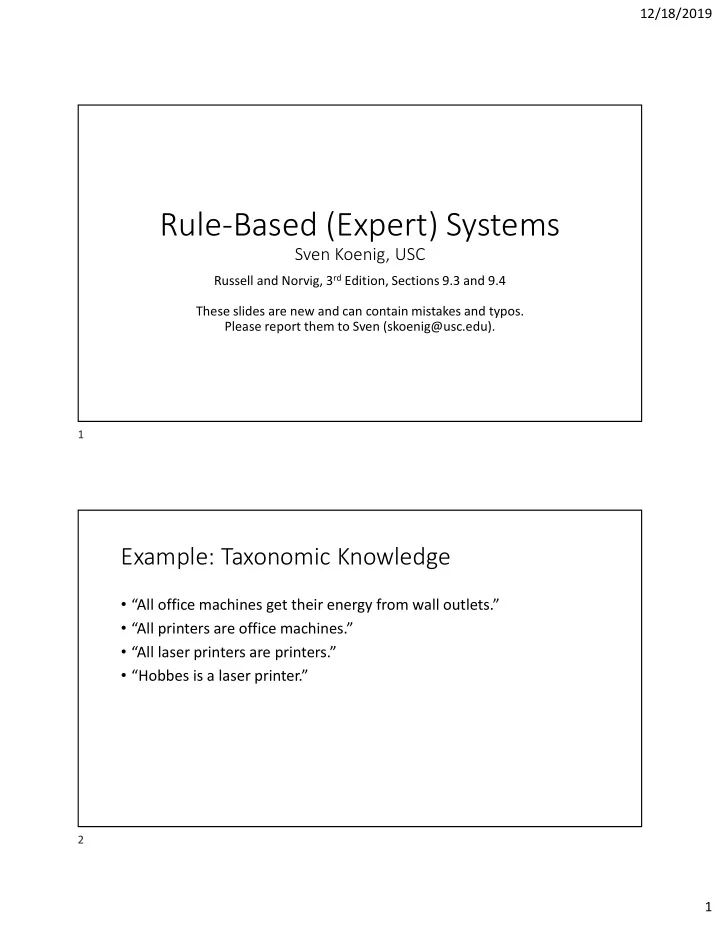

12/18/2019 Rule-Based (Expert) Systems Sven Koenig, USC Russell and Norvig, 3 rd Edition, Sections 9.3 and 9.4 These slides are new and can contain mistakes and typos. Please report them to Sven (skoenig@usc.edu). 1 Example: Taxonomic Knowledge • “All office machines get their energy from wall outlets.” • “All printers are office machines.” • “All laser printers are printers.” • “Hobbes is a laser printer.” 2 1
12/18/2019 Example: Taxonomic Knowledge • Knowledge base in first-order logic • FORALL x IsOfficeMachine(x) IMPLIES HasEnergySource(x, WallOutlet) • FORALL x IsPrinter(x) IMPLIES IsOfficeMachine(x) • FORALL x IsLaserPrinter(x) IMPLIES IsPrinter(x) • IsLaserPrinter(Hobbes) • We can use resolution to show that the knowledge base entails • HasEnergySource(Hobbes, WallOutlet) • But the knowledge base and resolution are difficult to understand by non-experts and resolution is often slow (and non-trivial to implement), so we are looking for alternative ways to represent knowledge and reason with it. 3 Modus Ponens P, P IMPLIES Q P(A), FORALL x (P(x) IMPLIES Q(x)) Modus Ponens (write: “ ⊢ ”) Q Q(A) Modus Ponens • Using KB ⊢ S to show KB ⊨ S is sound but not complete. • Example: P IMPLIES Q, NOT P IMPLIES Q ⊨ Q Modus Ponens but neither P IMPLIES Q, NOT P IMPLIES Q ⊢ Q Modus Ponens nor P IMPLIES Q, NOT P IMPLIES Q, NOT Q ⊢ FALSE 4 2
12/18/2019 Modus Ponens • Modus Ponens uses a fact “P(A)” and a rule “if P(x) then Q(x)” to produce a new fact “Q(A)”. P(A), FORALL x (P(x) IMPLIES Q(x)) Q(A) Fact If-then rule • • Fact about a patient Medical knowledge • • Knowledge the adventurer has about the Rules of the Wumpus World cave system in the Wumpus World 5 Rule-Based Systems (= Production Systems) • Knowledge base split into rule and working memory • Rule memory (contains rules, does not change during execution): if IsOfficeMachine(x) then HasEnergySource(x, WallOutlet) if IsPrinter(x) then IsOfficeMachine(x) if IsLaserPrinter(x) then IsPrinter(x) • Working memory (contains facts, changes during execution): IsLaserPrinter(Hobbes) 6 3
12/18/2019 Forward Chaining • Forward chaining is data-driven • When a new fact p is added to working memory for each rule R such that p unifies with a premise of R if the other premises of R are known then add the conclusion of R to working memory and repeat 7 Forward Chaining • Rule memory: if IsOfficeMachine(x) then HasEnergySource(x, WallOutlet) if IsPrinter(x) then IsOfficeMachine(x) if IsLaserPrinter(x) then IsPrinter(x) P(A), FORALL x (P(x) IMPLIES Q(x)) Q(A) • Working memory: remember: a sentence inferred by a sound IsLaserPrinter(Hobbes) inference rule can be put into the KB before IsPrinter(Hobbes) the inference rule is used again. 8 4
12/18/2019 Forward Chaining • Rule memory: if IsOfficeMachine(x) then HasEnergySource(x, WallOutlet) if IsPrinter(x) then IsOfficeMachine(x) if IsLaserPrinter(x) then IsPrinter(x) • Working memory: IsLaserPrinter(Hobbes) IsPrinter(Hobbes) IsOfficeMachine (Hobbes) HasEnergySource(Hobbes, WallOutlet) 9 Forward Chaining • Rule memory: if IsOfficeMachine(x) then add HasEnergySource(x, WallOutlet) if IsPrinter(x) then add IsOfficeMachine(x) if IsLaserPrinter(x) then add IsPrinter(x) Could use actions other than “add (to working memory)” here, such as “delete from working memory” or “print” • Working memory: IsLaserPrinter(Hobbes) 10 5
12/18/2019 Forward Chaining • Match phase (= find all applicable rules/unification binding combinations) • Conflict resolution phases (= choose one rule/unification binding) • Don’t fire (= use) a rule again with the same unification bindings • Use more recent facts from working memory • Use more specific rules if Mammal(x) then add Legs(x,4) if Mammal (x) and Human(x) then add Legs(x,2) • Use rules of higher given priority if ControlPanel(x) and Dusty(x) then execute Dust(x) if ControlPanel(x) and WarningLightOn(x) then execute Evacuate • Act phase (= execute the conclusion of the chosen rule/unification binding) 11 Backward Chaining • Backward chaining is query-driven (= hypothesis-driven) • When a new query q is asked if a fact q’ is in working memory that unifies with q then return the unifier of q and q’ else for each rule R such that q unifies with the conclusion of R pose each premise of R as new query and repeat 12 6
12/18/2019 Backward Chaining • Rule memory: if IsOfficeMachine(x) then HasEnergySource(x, WallOutlet) if IsPrinter(x) then IsOfficeMachine(x) if IsLaserPrinter(x) then IsPrinter(x) P(A), FORALL x (P(x) IMPLIES Q(x)) Q(A) • Working memory: IsLaserPrinter(Hobbes) Query: HasEnergySource(Hobbes, WallOutlet)? New Query: IsOfficeMachine(Hobbes)? 13 Backward Chaining • Rule memory: if IsOfficeMachine(x) then HasEnergySource(x, WallOutlet) if IsPrinter(x) then IsOfficeMachine(x) if IsLaserPrinter(x) then IsPrinter(x) • Working memory: IsLaserPrinter(Hobbes) Query: HasEnergySource(Hobbes, WallOutlet)? New Query: IsOfficeMachine(Hobbes)? New Query: IsPrinter(Hobbes)? New Query: IsLaserPrinter(Hobbes)? IsLaserPrinter(Hobbes) holds because it is in working memory. 14 7
12/18/2019 Rule-Based Systems (= Production Systems) • Forward chaining good for design (for example, configuration planning) good for some diagnosis (find out everything we can from symptoms) • Backward chaining good for some diagnosis (confirm hypothesis about diagnosis) 15 Rule-Based Systems (= Production Systems) • Modularity • Control isolated from knowledge base • Easy Modification • Explanation capability for its conclusions 16 8
12/18/2019 Rule-Based Systems (= Production Systems) • Conclusions are often not certain • if IsOfficeMachine(x) then HasEnergySource(x, WallOutlet) • If IsOfficeMachine(x) then it is highly likely that HasEnergySource(x, WallOutlet) • We discuss probabilistic expert systems later to address this issue. 17 9
Recommend
More recommend